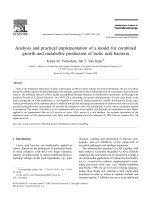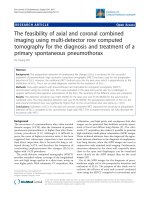rational and practical exfoliation of graphite using well defined poly 3 hexylthiophene for the preparation of conductive polymer graphene composite
Bạn đang xem bản rút gọn của tài liệu. Xem và tải ngay bản đầy đủ của tài liệu tại đây (867.14 KB, 8 trang )
www.nature.com/scientificreports
OPEN
received: 20 September 2016
accepted: 29 November 2016
Published: 06 January 2017
Rational and practical exfoliation
of graphite using well-defined
poly(3-hexylthiophene) for the
preparation of conductive polymer/
graphene composite
Hiroki Iguchi1, Chisato Higashi1, Yuichi Funasaki1, Keisuke Fujita1, Atsunori Mori1,
Akira Nakasuga2 & Tatsuo Maruyama1
Processing and manipulation of highly conductive pristine graphene in large quantities are still major
challenges in the practical application of graphene for electric device. In the present study, we report
the liquid-phase exfoliation of graphite in toluene using well-defined poly(3-hexylthiophene) (P3HT)
to produce a P3HT/graphene composite. We synthesize and use regioregular P3HT with controlled
molecular weights as conductive dispersants for graphene. Simple ultrasonication of graphite flakes
with the P3HT successfully produces single-layer and few-layer graphene sheets dispersed in toluene.
The produced P3HT/graphene composite can be used as conductive graphene ink, indicating that the
P3HT/graphene composite has high electrical conductivity owing to the high conductivity of P3HT and
graphene. The P3HT/graphene composite also works as an oxidation-resistant and conductive film for a
copper substrate, which is due to the high gas-barrier property of graphene.
Graphene is one of the most interesting nanomaterials owing to its unique properties, such as high electrical conductivity, high mechanical toughness, high gas-barrier performance, and unique optical properties1–3.
Industrial applications of graphene are expected in a wide range of areas, including electronic materials and
medical engineering. In particular, its application in electronics has been highly expected and widely studied.
Since the pioneering work on mechanical exfoliation for the production of graphene in 20041, a number of methods for the production of graphene have been proposed: for example, mechanical exfoliation1, chemical vapor
deposition (CVD)4,5, heat decomposition6, and chemical synthesis7. Many of these methods are costly, ineffective,
and non-scalable. ‘Liquid-phase exfoliation’ of graphite is one of the most inexpensively scalable approaches.
However, graphene usually aggregates in solvents because of the strong hydrophobic interaction and van der
Waals force between graphene sheets. The aggregation causes a loss of favorable properties and increases the
difficulty for the practical manipulation of graphene. Liquid-phase exfoliation is divided into chemical and physical processes. Ever since chemically exfoliated graphene (e.g., graphene oxide, acidified graphene, and reduced
graphene oxide) was shown to have a number of structural defects8,9, recent studies have focused on a physical
process, especially on pristine graphene produced by the liquid-phase exfoliation of graphite. Various types of
dispersants (surfactants, polymers, ionic liquids, proteins, and nanotubes) have been proposed for the direct
production of pristine graphene from graphite10–16. Many of these dispersants, however, decrease the electrical
conductivity of graphene because they disrupt the extended aromatic conjugated systems and cover the graphene
with nonconductive molecules16,17.
Poly(3-hexylthiophene) (P3HT) has attracted attention in fields such as material science and electronics
owing to its high electrical conductivity and its processability18. Although π–πinteractions between P3HT and
carbon nanomaterials (carbon nanotubes and graphene oxides) have been observed19–24, there is, to the best
1
Department of Chemical Science and Engineering, Graduate School of Engineering, Kobe University, 1-1
Rokkodaicho, Nada-ku, Kobe 657-8501, Japan. 2Sekisui Chemical Co., Ltd., 2-1 Hyakuyama, Shimamoto-cho,
Mishima-gun, Osaka 618-0021, Japan. Correspondence and requests for materials should be addressed to T.M.
(email: )
Scientific Reports | 7:39937 | DOI: 10.1038/srep39937
1
www.nature.com/scientificreports/
Figure 1. Schematic illustration of the exfoliation of graphite and the graphene dispersion using poly(3hexylthiophene).
of our knowledge, no report on the exfoliation of pristine graphite using P3HT to produce a stable dispersion
of graphene. Regioregularity of P3HT plays an important role in the electrical conductivity of P3HT18. Our
group has already succeeded in the regiochemically-controlled synthesis of P3HT having controlled molecular
weights25–27. In this study, we propose the exfoliation of pristine graphite in toluene using well-defined P3HT
as a conductive dispersant to produce pristine graphene without loss of the electrical conductivity (Fig. 1).
The present study also demonstrates that the P3HT/graphene composite can be used as conductive ink and an
oxidation-resistant film for a metal substrate.
Methods
Materials. Graphite flakes and copper-plated divinylbenzene microparticles (CuMPs) were provided by
Sekisui Chemical Co., Ltd. (Tokyo, Japan). 2-Bromo-3-hexylthiophene and [1,3-bis(2,6-diisopropylphenyl)imidazol-2-ylidene]triphenylphosphine nickel(II) dichloride (NiCl2(PPh3)IPr) were purchased from Tokyo Chemical
Industries, Ltd. (Tokyo, Japan). 2,2,6,6-Tetramethylpiperidinylmagnesium chloride lithium chloride complex
(TMPMgCl·LiCl) solution was purchased from Sigma (St. Louis, MO). Other chemicals were purchased from
Wako PureChemical Industries, Ltd. (Osaka, Japan). The water used was high-quality deionized water (Milli-Q
water, >15 MΩ cm−1) produced using a Milli-Q Advantage A100 system equipped with an Elix UV 3 system
(Millipore, Molsheim, France).
Polymerization of 2-bromo-3-hexylthiophene using a Knochel-Hauser base. P3HT was synthesized by the slightly modified procedure previously reported by us25–27. To a THF solution containing 1.0 M
TMPMgCl·LiCl (1.56 mmol), 2-bromo-3-hexylthiophene (1.3 mmol, 324 mg) was added dropwise at 25 °C. After
stirring at 25 °C for 3 h, THF (20 mL) and NiCl2(PPh3)IPr (28.3 mg, 0.036 mmol) were successively added. The
resulting mixture was stirred at 25 °C for 1 h. Hydrochloric acid (1.0 M, 20 mL) and methanol (20 mL) were added
to form a precipitate. The mixture was filtered and the residue was washed with methanol and n-hexane repeatedly
to obtain a dark purple solid, which was dried under reduced pressure to yield 144 mg of poly(3-hexylthiophene)
(P3HT) (66%). Molecular weights and the molecular weight distribution of P3HT were estimated by SEC analysis (eluent: CHCl3) using polystyrene as the molecular weight standard. For example, SEC analysis showed
Mn = 6000, and Mw/Mn = 1.10. The regioregularity was estimated by 1H NMR analysis (thienyl-CH2- signals) at
the δ2.80 (H-T) and δ2.60 (H-H) signals (H-T regioregularity = 97%).
Regio-irregular P3HT (H-T regioregularity 77%, Mn 7000 and Mw/Mn = 1.6) was synthesized according to a
previous report28.
Preparation of graphene dispersion with P3HT. Graphite flakes were ultrasonicated (AsOne
Corporation., Ultrasonic cleaner VS-D100, 31 kHz) with P3HT in toluene at 80 °C for 30 min, followed by
incubation at 30 °C for 15 min. The concentration of graphite flakes was 0.33 mg mL−1. By adding the different
quantities of P3HT, the mixed ratios of P3HT/graphite were varied to 0, 0.1, 0.2, 0.5, 0.75, 1.0, and 1.5 wt/wt.
Following ultrasonication, the dispersions were centrifuged (Hitachi Koki Co., Ltd., CF15RX) at 1000 × g for
20 min to remove the unexfoliated particles and thick flakes of graphite. Then, the supernatant was collected as
the graphene dispersion.
Preparation of P3HT/graphene composite film-paper. P3HT/graphene composite film-papers were
prepared by vaccum filtration. Graphene dispersions (3 ml) containing 42 μg graphene, which were prepared
using P3HT (Mn = 6,000) or SDS, were filtrated through filter paper that were 8 mm in diameter and 4 μm of pore
size (Kiriyama Grass Co., Ltd.). P3HT/graphene (or SDS/graphene) on the filter paper was dried at 100 °C for
5 min to ensure complete solvent evaporation.
Preparation of P3HT/graphene-coated CuMPs. The CuMPs were rinsed with H2SO4 aqueous solution
(0.1 M) for 10 min at 25 °C to remove copper oxide from the surfaces. Then, they were rinsed with excess amounts
of water and ethanol three times each. P3HT- and P3HT/graphene-coated CuMPs were prepared by dip-coating
the rinsed CuMPs (20 mg) in P3HT/graphene dispersion (400 μL) for 1.5 h at 40 °C, followed by the removal of the
supernatant by vaccum evaporation overnight to dry the P3HT/graphene-coated CuMPs.
Scientific Reports | 7:39937 | DOI: 10.1038/srep39937
2
www.nature.com/scientificreports/
Figure 2. (a) Polymerization of 2-bromo-3-hexylthiophene using the Knochel-Hauser base and a nickel
catalyst. (b) Size-exclusion chromatography (SEC) profiles of synthesized P3HT with different Mn. (c) Numberaverage molecular weights and polydispersity indices (Mw/Mn) of synthesized P3HT.
Sample characterization. UV/Vis absorption spectra of the dispersions (200–900 nm) were recorded using
a double-beam spectrophotometer (JASCO, V-770). Since P3HT did not exhibit an absorbance around 660 nm,
absorption measurements at 660 nm allowed us to evaluate the concentration of dispersed graphene in toluene.
Raman spectroscopy measurements were performed on a Nano-Raman system WITec alpha300R using a
laser excitation at 532 nm (Nd-YAG-neodymium-doped yttrium aluminium garnet type laser) at 3 mW.
TEM images were obtained using a JEOL 2100 F transmission electron microscope operated at 200 kV. A drop
of graphene dispersion was placed on a copper grid covered with elastic carbon films manufactured by Okenshoji
Co., Ltd. and dried under vaccum at ambient temperature.
AFM images were obtained in a tapping mode using Hitachi Nanonavi E-sweep with cantilevers at
17,000 N m−1. SEM observations were performed using a JEOL JSM-7500F scanning electron microscope.
Electrical resistance measurements were performed using a four-point-probe ohmmeter (Mitsubishi
Chemical Analytec Co., Ltd. LorestaAX MCP-T370, TFP-prove) for P3HT/graphene composite paper films and
a digital multimeter (Custom Co., Ltd. CDM-200D) for CuMPs.
Results
Regioregular P3HT with controlled molecular weights were synthesized according to our previous report
(Fig. 2a)25. Figure 2b shows the elution profiles of the synthesized P3HT from size-exclusion chromatography
(SEC). The SEC profiles reveal that the synthesized P3HT had Mn ranging from 6,000 to 75,000 with a very narrow distribution of molecular weights (Mw/Mn was from 1.04 to 1.21, Fig. 2c), which agrees with our previous
reports25–27.
Graphite flakes (Fig. S1, Supporting Information) were mixed with P3HT in toluene and ultrasonicated at
80 °C for 30 min. After centrifugation, the resultant toluene solution containing P3HT and graphene was dark
brown (inset of Fig. 3a). Figure S2 shows the absorption spectra of the P3HT and P3HT/graphene solutions.
The P3HT/graphene solution exhibits a plateau absorbance over 600 nm, which was not observed in the P3HT
solution. These results indicate the exfoliation of graphite by P3HT in toluene to produce the P3HT/graphene
dispersion12.
We evaluated the effect of the Mn of P3HT on the dispersing graphene by measuring the absorbance of the
P3HT/graphene dispersion at 660 nm12. Figure 3a reveals that low-molecular-weight P3HT (Mn = 6,000) was the
most effective in dispersing graphene. P3HT with molecular weights of more than 40,000 resulted in low graphene
concentrations in the dispersion, which might be related to the low solubility of the high-molecular-weight P3HT
in toluene18,29.
The effect of the P3HT/graphite ratio on dispersing graphene was also investigated (Fig. 3b). As the ratio
was increased up to 1.0, the dispersing ability of P3HT increased. At a ratio of 1.5, the dispersing ability slightly
decreased. When P3HT with Mn 6,000 was used and the P3HT/graphite was 1.0, the graphene concentration in
toluene was 14 μg mL−1, in which the yield of graphene was 3.5%.
We also used relatively regio-irregular P3HT (H-T regioregularity 77%, Mn 7000 and Mw/Mn = 1.6) at a P3HT/
graphite ratio of 1.0 to exfoliate graphite and to disperse graphene in toluene. Interestingly, there observed negligible absorbance at 660 nm (Fig. S3), meaning almost no exfoliation of graphite and no graphene dispersion. The
twisted structure of the regio-irregular P3HT might inhibit its intercalation into graphite and might be unable to
form a stable composite with a graphene sheet. These results proved the importance of the P3HT regioregularity
in the exfoliation of graphite and in the dispersion of graphene. The following experiments were carried out using
regioregular P3HT with Mn of 6,000 and at a P3HT/graphite ratio of 1.0.
Scientific Reports | 7:39937 | DOI: 10.1038/srep39937
3
www.nature.com/scientificreports/
Figure 3. Absorbance at 660 nm of graphene dispersions in toluene. (a) Effect of different Mn of P3HT (the
P3HT/graphite ratio was 1.0) and (b) effect of different mixed ratios of P3HT (Mn = 6,000)/graphite on the
absorbance. The concentration of graphite flakes was 0.33 mg mL−1. The inset represents a photo of a P3HT
(Mn = 6000)/graphene dispersion.
The P3HT/graphene dispersion was characterized using a transmission electron microscope (TEM), an
atomic force microscope (AFM), and Raman spectroscopy. TEM images of the P3HT/graphene dispersion are
shown in Fig. 4a and b. Large graphene sheets with lateral dimensions of 0.1–2 μm were observed. Tri-layer
and single-layer graphene were observed by considering the edge of the graphene in Fig. 4a and b, respectively.
Nanowires of P3HT were also observed, which is consistent with a previous report21. Figure 4c shows the AFM
image of the P3HT/graphene dispersion deposited on a mica substrate and the height profile along the red line in
the figure revealed that the thickness of P3HT/graphene was 2.6 nm, which corresponded to tri-layer graphene
with P3HT15. These observations clearly demonstrate that graphite flakes were exfoliated by P3HT to produce
single-layer and few-layer graphene sheets.
The above investigations suggest that P3HT works as a dispersant for graphene in toluene. Defects in graphene
often occur during the exfoliation of graphite and dispersion of graphene in solvents30,31. We measured the Raman
spectra of graphite flakes and the dry P3HT/graphene composite. Figure 4d shows the D band (1360 cm−1), G
band (1584 cm−1), and 2D band (2680 cm−1) of the analytes32,33. The D/G band intensity ratio indicates the degree
of structural defects in graphene32. The dry P3HT/graphene composite showed an ID/IG ratio of 0.63, which was
almost the same as that of the graphite flakes. These measurements indicate that defects in the graphene sheet did
not occur during the P3HT-induced exfoliation of the graphite and graphene dispersion.
To investigate the electrical property of the P3HT/graphene composite, P3HT/graphene and sodium dodecyl
sulfate (SDS)/graphene composites on filter paper were prepared by vacuum filtration of the graphene dispersion
(Fig. 5a)34. The sheet resistance of the P3HT/graphene composite was 1.8 ± 0.5 kΩsq−1, which was much smaller
than that of the SDS/graphene composite (31.6 ± 3.0 kΩsq−1). The resistance of the P3HT/graphene-composite
was comparable with those of graphene films with other dispersants11,15,35, of CVD-grown graphene36,37 and of
commercially available graphene38. We assembled the P3HT/graphene composite with a circuit and succeeded
in energization (LED lighting in Fig. 5b). The remarkably low resistance of the P3HT/graphene composite arose
from the high conductivity of P3HT. These investigations proved the great potential of the P3HT/graphene dispersion for use as conductive ink12,35,39,40.
One of the unique properties of graphene is its molecular barrier property, which prevents gas permeation3,41–43. We anticipated that the P3HT/graphene composite can be used for the anti-oxidation of oxidizable
metal substrates in electronics. Gold- and silver-coated substrates are widely used in electronics and in electrical
appliances owing to their high conductivity and high stability in the atmosphere. Although the replacement of
these precious metals with base metals (e.g., Cu and Ni) is very cost-effective, a major drawback in the electric
industry is that base metals are readily oxidized in the atmosphere to produce non-conductive metal oxides.
We prepared Cu-microparticles (CuMPs, 0.2 mm in diameter) coated with the P3HT/graphene composite by
dip-coating to evaluate the anti-oxidation property of the P3HT/graphene coating.
Figure 5c shows that the electrical resistance of bare CuMPs was 0.6 ± 0.2 Ω and that the oxidation treatment
increased the resistance by more than 4 times (2.3 ± 0.1 Ω). The P3HT-coated CuMPs exhibited a resistance of
Scientific Reports | 7:39937 | DOI: 10.1038/srep39937
4
www.nature.com/scientificreports/
Figure 4. (a,b) TEM images of graphene sheets with P3HT (Mn = 6,000). (c) AFM image of P3HT/graphene
deposited on a mica substrate with a height profile along the red line. (d) Raman spectra of graphite flakes and
P3HT/graphene composite. P3HT (Mn = 6,000) was used for preparing the P3HT/graphene complex.
1.3 ± 0.1 Ω before oxidation and 1.6 ± 0.3 Ω after oxidation. Although the sole P3HT coating also suppressed the
oxidation to a certain extent, the intrinsic resistance of the P3HT-coated CuMPs was relatively high. The P3HT/
graphene-coated CuMPs exhibited a resistance of 0.8 ± 0.2 Ω before oxidation, which was comparable with that
of the bare CuMPs. After the oxidation treatment, the resistance of the P3HT/graphene-coated CuMPs remained
at 0.7 ± 0.2 Ω, which was as low as that of the bare CuMPs. These results show that the P3HT/graphene coating
prevented Cu oxidation and maintained the intrinsic resistance of the CuMPs.
To verify the coatings on the CuMPs, we recorded the Raman spectra for the surfaces of the bare and coated
CuMPs before and after the oxidation treatment. Figure 5d shows small peaks at 600 and 220 cm−1 (red arrows
in Fig. 5d) for the bare CuMPs and the P3HT-coated CuMPs after the oxidation treatment, which result from the
production of CuO and Cu2O. The observed peaks for P3HT are at 2,900 and 1,500 cm−1 (blue arrows in Fig. 5d)
in the spectra of the P3HT-coated CuMPs. These results suggest successful P3HT coating of CuMPs and Cu oxidation for the P3HT-coated CuMPs by the oxidation treatment. In the spectrum of the P3HT/graphene-coated
CuMPs, no peaks for copper oxide were observed while peaks for graphene (D, G, and 2D band) and peaks for
P3HT were observed, showing the inhibition of Cu oxidation and the successful P3HT/graphene coating. The
inhibition of Cu oxidation is proposed to arise from the high gas-barrier property of graphene. It should be noted
that a peak at 1600 cm−1 was assigned as a G peak of graphene32,33.
Figure S4 (Supporting Information) shows the FE-SEM images of bare, and P3HT- and P3HT/graphene-coated
CuMPs. A wrinkled morphology was observed on the surface of the P3HT-coated CuMPs in the magnified image
(right photographs of Fig. S4b, Supporting Information). The P3HT/graphene-coated CuMPs also had a wrinkled
surface, which was more obvious in the left of Fig. S4c than in Fig. S4b (Supporting Information). These wrinkled
morphologies provided evidence for the coatings of P3HT and the P3HT/graphene on CuMPs.
Discussion
In this study, we first succeeded in the exfoliation of pristine graphite using well-defined P3HT to stably disperse
graphene in toluene. In particular, regioregular P3HT with Mn of 6,000 was found to effectively exfoliate graphite
Scientific Reports | 7:39937 | DOI: 10.1038/srep39937
5
www.nature.com/scientificreports/
Figure 5. (a) P3HT/graphene composite filtrated and collected on filter paper. Scale bar represents 2 mm.
(b) Photograph of a lit LED assembled with a P3HT/graphene composite and a battery. (c) Electrical resistance
and photographs of bare CuMPs, P3HT-coated CuMPs, and P3HT/graphene-coated CuMPs before and after
oxidation. (d) Raman spectra of bare CuMPs, P3HT-coated CuMPs, and P3HT/graphene-coated CuMPs before
(black) and after (red) oxidation treatment.
flakes to produce graphene and to stably disperse graphene in toluene, in which π–πinteraction between P3HT
and graphene would play an important role in the formation of the P3HT/graphene composite. The regioregularity of P3HT was also important for the exfoliation of graphite and the dispersion of graphene. The P3HT/
graphene composite showed high electrical conductivity owing to the high conductivity of P3HT and graphene,
which proposes the potential application of the P3HT/graphene dispersion as conductive graphene ink. The
investigations on the P3HT/graphene coating interestingly demonstrate that the P3HT/graphene composite can
be used as an oxidation-resistant and conductive film for a copper substrate. Liquid-phase exfoliation of pristine graphite and stable dispersion of graphene, without losing the properties of graphene, extend the practical
applications of graphene. Although there were, to the best of our knowledge, only a few reports that proposed
the application of graphene utilizing both its electrical conductivity and gas-barrier property36,44,45, the present
study clearly demonstrates the high potential of the P3HT/graphene composite as a gas barrier and conductive
nanomaterial that is scalable and processable.
References
1. Novoselov, K. S. et al. Electric field effect in atomically thin carbon films. Science 306, 666–669 (2004).
2. Geim, A. K. & Novoselov, K. S. The rise of graphene. Nat. Mater. 6, 183–191 (2007).
3. Novoselov, K. S. et al. A roadmap for graphene. Nature 490, 192–200 (2012).
4. Reina, A. et al. Large area, few-layer graphene films on arbitrary substrates by chemical vapor deposition. Nano Lett. 9, 30–35 (2009).
5. Kim, K. S. et al. Large-scale pattern growth of graphene films for stretchable transparent electrodes. Nature 457, 706–710 (2009).
6. Berger, C. et al. Electronic confinement and coherence in patterned epitaxial graphene. Science 312, 1191–1196 (2006).
7. Salvatierra, R. V., Cava, C. E., Roman, L. S., Oliveira, M. M. & Zarbin, A. J. G. The total chemical synthesis of polymer/graphene
nanocomposite films. Chem. Commun. 52, 1629–1632 (2016).
8. Bianco, A. et al. All in the graphene family - A recommended nomenclature for two-dimensional carbon materials. Carbon 65, 1–6
(2013).
9. Wick, P. et al. Classification framework for graphene-based materials. Angew. Chem. Int. Ed. 53, 7714–7718 (2014).
10. Laaksonen, P. et al. Interfacial engineering by proteins: exfoliation and functionalization of graphene by hydrophobins. Angew.
Chem. Int. Ed. 49, 4946–4949 (2010).
11. Liang, Y. T. & Hersam, M. C. Highly Concentrated Graphene Solutions via Polymer Enhanced Solvent Exfoliation and Iterative
Solvent Exchange. J. Am. Chem. Soc. 132, 17661–17663 (2010).
12. Guardia, L. et al. High-throughput production of pristine graphene in an aqueous dispersion assisted by non-ionic surfactants.
Carbon 49, 1653–1662 (2011).
Scientific Reports | 7:39937 | DOI: 10.1038/srep39937
6
www.nature.com/scientificreports/
13. Wajid, A. S. et al. Polymer-stabilized graphene dispersions at high concentrations in organic solvents for composite production.
Carbon 50, 526–534 (2012).
14. He, P. et al. Urea-assisted aqueous exfoliation of graphite for obtaining high-quality graphene. Chem. Commun. 51, 4651–4654
(2015).
15. Matsumoto, M., Saito, Y., Park, C., Fukushima, T. & Aida, T. Ultrahigh-throughput exfoliation of graphite into pristine ‘single-layer’
graphene using microwaves and molecularly engineered ionic liquids. Nat. Chem. 7, 730–736 (2015).
16. Georgakilas, V. et al. Hydrophilic Nanotube Supported Graphene-Water Dispersible Carbon Superstructure with Excellent
Conductivity. Adv. Funct. Mater. 25, 1481–1487 (2015).
17. Georgakilas, V. et al. Functionalization of graphene: covalent and non-covalent approaches, derivatives and applications. Chem Rev
112, 6156–6214 (2012).
18. McCullough, R. D. The chemistry of conducting polythiophenes. Adv. Mater. 10, 93–116 (1998).
19. Tasis, D., Tagmatarchis, N., Bianco, A. & Prato, M. Chemistry of carbon nanotubes. Chem Rev 106, 1105–1136 (2006).
20. Kuila, B. K., Malik, S., Batabyal, S. K. & Nandi, A. K. In-situ synthesis of soluble poly(3-hexylthiophene)/multiwalled carbon
nanotube composite: Morphology, structure, and conductivity. Macromolecules 40, 278–287 (2007).
21. Chunder, A., Liu, J. H. & Zhai, L. Reduced Graphene Oxide/Poly(3-hexylthiophene) Supramolecular Composites. Macromol. Rapid.
Commun. 31, 380–384 (2010).
22. Saini, V. et al. Electrical, Optical, and Morphological Properties of P3HT-MWNT Nanocomposites Prepared by in Situ
Polymerization. J. Phys. Chem. C 113, 8023–8029 (2009).
23. Yang, Z. L., Shi, X. J., Yuan, J. J., Pu, H. T. & Liu, Y. S. Preparation of poly(3-hexylthiophene)/graphene nanocomposite via in situ
reduction of modified graphite oxide sheets. Appl. Surf. Sci. 257, 138–142 (2010).
24. Bkakri, R. et al. Effects of the graphene content on the conversion efficiency of P3HT: Graphene based organic solar cells. J. Phys.
Chem. Solids 85, 206–211 (2015).
25. Tamba, S. et al. Nickel-catalyzed Dehydrobrominative Polycondensation for the Practical Preparation of Regioregular Poly(3substituted thiophene)s. Chem. Lett. 40, 398–399 (2011).
26. Tamba, S., Shono, K., Sugie, A. & Mori, A. C-H functionalization polycondensation of chlorothiophenes in the presence of nickel
catalyst with stoichiometric or catalytically generated magnesium amide. J. Am. Chem. Soc. 133, 9700–9703 (2011).
27. Tanaka, S., Tamba, S., Tanaka, D., Sugie, A. & Mori, A. Synthesis of well-defined head-to-tail-type oligothiophenes by regioselective
deprotonation of 3-substituted thiophenes and nickel-catalyzed cross-coupling reaction. J. Am. Chem. Soc. 133, 16734–16737
(2011).
28. Fukumoto, H., Omori, Y. & Yamamoto, T. Effects of solvent and temperature on regioregularity of poly(3-hexylthiophene-2,5-diyl)
prepared by chemical oxidative polymerization. Polymer J. 45, 462–465 (2013).
29. Fujita, K. et al. Synthesis of Poly(3-substituted thiophene)s of Remarkably High Solubility in Hydrocarbon via Nickel-Catalyzed
Deprotonative Cross-Coupling Polycondensation. Macromolecules 49, 1259–1269 (2016).
30. Gomez-Navarro, C. et al. Electronic transport properties of individual chemically reduced graphene oxide sheets. Nano Lett. 7,
3499–3503 (2007).
31. Kudin, K. N., Ozbas, B., Schniepp, H. C., Prud’homme, R. K., Aksay, I. A. & Car, R. Raman spectra of graphite oxide and
functionalized graphene sheets. Nano Lett. 8, 36–41 (2008).
32. Ferrari, A. C. et al. Raman spectrum of graphene and graphene layers. Phys. Rev. Lett. 97 (2006).
33. Hernandez, Y. et al. High-yield production of graphene by liquid-phase exfoliation of graphite. Nat. Nanotechnol. 3, 563–568 (2008).
34. Higashi, C., Funasaki, Y., Iguchi, H. & Maruyama, T. In-situ polymerization of a novel surfactant on graphene surface for the stable
graphene dispersion in water. RSC Adv 6, 88244–88247 (2016).
35. Torrisi, F. et al. Inkjet-printed graphene electronics. ACS Nano. 6, 2992–3006 (2012).
36. Deng, B. et al. Roll-to-Roll Encapsulation of Metal Nanowires between Graphene and Plastic Substrate for High-Performance
Flexible Transparent Electrodes. Nano. Lett. 15, 4206–4213 (2015).
37. Ho, D. H. et al. Stretchable and Multimodal All Graphene Electronic Skin. Adv. Mater. 28, 2601–2608 (2016).
38. />39. Xu, Y. X., Bai, H., Lu, G. W., Li, C. & Shi, G. Q. Flexible graphene films via the filtration of water-soluble noncovalent functionalized
graphene sheets. J. Am. Chem. Soc. 130, 5856–5857 (2008).
40. Hyun, W. J. et al. All-Printed, Foldable Organic Thin-Film Transistors on Glassine Paper. Adv. Mater. 27, 7058–7064 (2015).
41. Park, S. & Ruoff, R. S. Chemical methods for the production of graphenes. Nat. Nanotechnol. 4, 217–224 (2009).
42. Sadasivuni, K. K., Ponnamma, D., Thomas, S. & Grohens, Y. Evolution from graphite to graphene elastomer composites. Prog.
Polym. Sci. 39, 749–780 (2014).
43. Cui, Y. B., Kundalwal, S. I. & Kumar, S. Gas barrier performance of graphene/polymer nanocomposites. Carbon 98, 313–333
(2016).
44. Chang, C. H. et al. Novel anticorrosion coatings prepared from polyaniline/graphene composites. Carbon 50, 5044–5051 (2012).
45. Lin, Y., Liu, S. Q. & Liu, L. A new approach to construct three dimensional segregated graphene structures in rubber composites for
enhanced conductive, mechanical and barrier properties. J. Mater. Chem. C 4, 2353–2358 (2016).
Acknowledgements
This work was supported partially by Special Coordination Funds for Promoting Science and Technology,
Creation of Innovation Centers for Advanced Interdisciplinary Research Areas (Innovative Bioproduction Kobe),
MEXT, Japan and by JSPS KAKENHI Grant Number 16H04577.
Author Contributions
All authors discussed the results and commented on the manuscript. A.N. and T.M. designed the project.
H.I., K.F. and A.M. synthesized P3HT. H.I., C.H. and Y.F. performed the graphene dispersion and structural
characterizations. H.I. and T.M. wrote the manuscript.
Additional Information
Supplementary information accompanies this paper at />Competing financial interests: The authors declare no competing financial interests.
How to cite this article: Iguchi, H. et al. Rational and practical exfoliation of graphite using well-defined
poly(3-hexylthiophene) for the preparation of conductive polymer/graphene composite. Sci. Rep. 7, 39937;
doi: 10.1038/srep39937 (2017).
Scientific Reports | 7:39937 | DOI: 10.1038/srep39937
7
www.nature.com/scientificreports/
Publisher's note: Springer Nature remains neutral with regard to jurisdictional claims in published maps and
institutional affiliations.
This work is licensed under a Creative Commons Attribution 4.0 International License. The images
or other third party material in this article are included in the article’s Creative Commons license,
unless indicated otherwise in the credit line; if the material is not included under the Creative Commons license,
users will need to obtain permission from the license holder to reproduce the material. To view a copy of this
license, visit />© The Author(s) 2017
Scientific Reports | 7:39937 | DOI: 10.1038/srep39937
8









